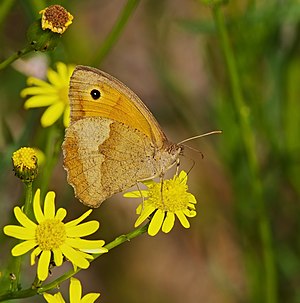Big ox eye
| Big ox eye | ||||||||||||
|---|---|---|---|---|---|---|---|---|---|---|---|---|

Great ox-eye ( Maniola jurtina ), ♀ |
||||||||||||
| Systematics | ||||||||||||
|
||||||||||||
| Scientific name | ||||||||||||
| Maniola jurtina | ||||||||||||
| ( Linnaeus , 1758) |
The great ox-eye ( Maniola jurtina ) is a butterfly from the noble butterfly family (Nymphalidae).
features
The moths reach a wingspan of 40 to 48 millimeters. Male and female moths differ in their coloring ( sexual dichroism ). The males have almost monochrome dark brown colored wing tops. On the forewings, near the base, a somewhat darker scented scented spot can be seen, near the wing tip there is a tightly orange-rimmed, white core, black eye-spot . The females also have dark brown wing tops, but on the forewings they have an extensive, more or less opaque orange spot that covers the entire center of the wing. They also have an eye spot near the wing tip, but this is significantly larger than that of the males. The undersides are colored about the same in both sexes. The underside of the forewings is broadly orange in color, only the edge is gray-brown. The eye spot on the front can also be found in the same place, sometimes it is also double white. The underside of the hind wings is predominantly gray-brown in color and has fine, black speckles. In the posterior part of the wing (post-disk region) a broad, light-colored bandage can be seen, especially towards the rear.
The caterpillars are about 25 millimeters long and are colored light green. They have a fine, light longitudinal line below the stigma and all over their body they have long, white hair that is curved at the tip.
Similar species
- Lesser ox-eye ( Hyponephele lycaon )
- Red-brown ox-eye ( Pyronia tithonus )
- Sardinian ox-eye ( Maniola nurag )
- Hyponephele lupina
- Maniola telmessia
Occurrence
The animals come from the Canary Islands , across North Africa and all of Europe , except the far north, across Asia Minor and the north of Iran and Iraq , east to western Siberia . They can be found in the lowlands up to around 1,600 meters above sea level, in North Africa up to 2,500 meters. They live in open, dry to slightly damp places, such as on the edges of forests, on dry grass and on the edge of moors . They are widespread and are one of the most common types of butterfly and are common even in gardens.
Way of life
Especially in the Mediterranean region , the moths have a one-month diapause in midsummer and rest in a shady place. The females can live to be up to 40 days old.
Flight and caterpillar times
The moths fly in one generation from early June to early September. The caterpillars can be found from September and after wintering until May. Even in the hot regions, where they fly between the end of March and the end of September, only one generation occurs.
Food of the caterpillars
The caterpillars feed on many grasses (Poaceae), such as from upright brome ( Bromus erectus ), sheep fescue ( Festuca ovina ), Kentucky bluegrass ( Poa pratensis ), Woolly honey grass ( Holcus lanatus ), fluffy meadow oats ( Helictotrichon pubescens ), Meadow foxtail ( Alopecurus pratensis ), common stalk grass ( Anthoxanthum odoratum ) and pinnate twinkles ( Brachypodium pinnatum ).
development
The females lay their cone-shaped, flattened and strongly ribbed eggs one by one close to the ground on sometimes withered fodder plants. The hatching caterpillars are initially diurnal. The wintering takes place as a young caterpillar. This is active on frost-free days. They are nocturnal after the penultimate or last moult after wintering. They pupate just above the ground in a yellowish-green to purple-red tumbled pupa , which has brownish stripes, on a dry stem.
swell
Individual evidence
- ↑ a b c Heiko Bellmann : The new Kosmos butterfly guide. Butterflies, caterpillars and forage plants. Franckh-Kosmos, Stuttgart 2003, ISBN 3-440-09330-1 , p. 200.
- ↑ a b c Tom Tolman, Richard Lewington: Die Tagfalter Europäische und Nordwestafrikas , p. 230, Franckh-Kosmos Verlags-GmbH & Co, Stuttgart 1998, ISBN 3-440-07573-7
- ↑ a b Hans-Josef Weidemann: Butterfly: observe, determine . S. 518f, Naturbuch-Verlag, Augsburg 1995, ISBN 3-89440-115-X
- ↑ Manfred Koch : We identify butterflies. Volume 1: Butterfly. 4th enlarged edition. Neumann, Radebeul / Berlin 1966, DNB 457244224 , p. 86f.
Web links
- Lepiforum e. V. Taxonomy and Photos
- Species portraits of butterflies in Rhineland-Palatinate - Large ox-eye
- Moths and Butterflies of Europe and North Africa (English)
- www.schmetterling-raupe.de
- Maniola jurtina at Fauna Europaea


